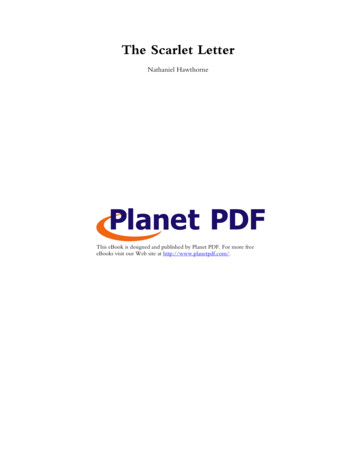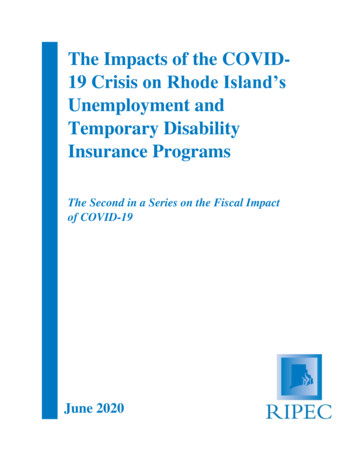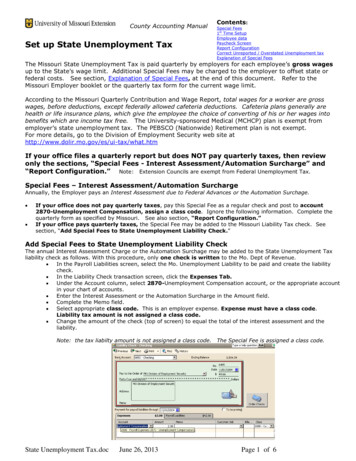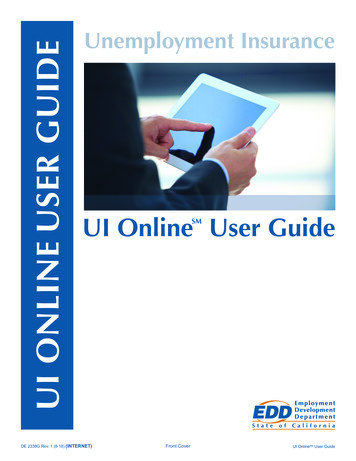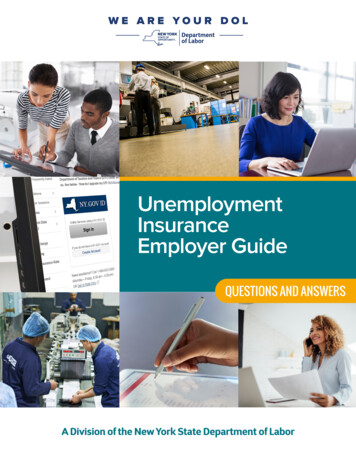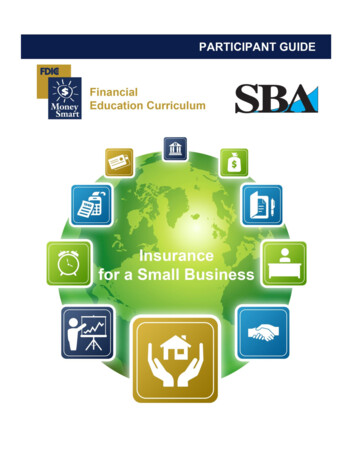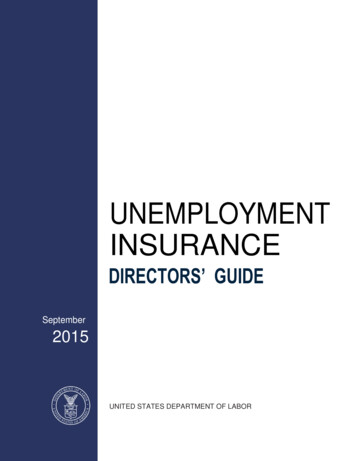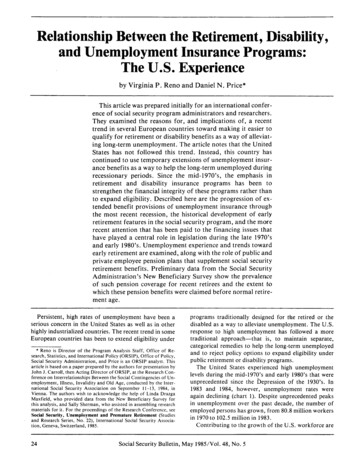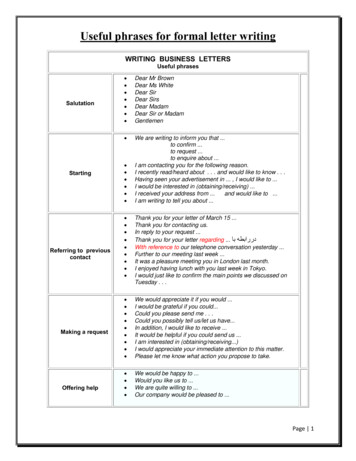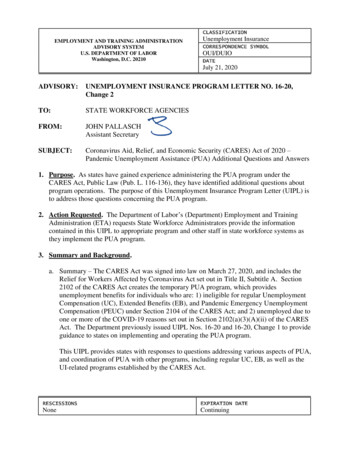
Transcription
CLASSIFICATIONEMPLOYMENT AND TRAINING ADMINISTRATIONADVISORY SYSTEMU.S. DEPARTMENT OF LABORWashington, D.C. 20210Unemployment InsuranceCORRESPONDENCE SYMBOLOUI/DUIODATEJuly 21, 2020ADVISORY:UNEMPLOYMENT INSURANCE PROGRAM LETTER NO. 16-20,Change 2TO:STATE WORKFORCE AGENCIESFROM:JOHN PALLASCHAssistant SecretarySUBJECT:Coronavirus Aid, Relief, and Economic Security (CARES) Act of 2020 –Pandemic Unemployment Assistance (PUA) Additional Questions and Answers1. Purpose. As states have gained experience administering the PUA program under theCARES Act, Public Law (Pub. L. 116-136), they have identified additional questions aboutprogram operations. The purpose of this Unemployment Insurance Program Letter (UIPL) isto address those questions concerning the PUA program.2. Action Requested. The Department of Labor’s (Department) Employment and TrainingAdministration (ETA) requests State Workforce Administrators provide the informationcontained in this UIPL to appropriate program and other staff in state workforce systems asthey implement the PUA program.3. Summary and Background.a. Summary – The CARES Act was signed into law on March 27, 2020, and includes theRelief for Workers Affected by Coronavirus Act set out in Title II, Subtitle A. Section2102 of the CARES Act creates the temporary PUA program, which providesunemployment benefits for individuals who are: 1) ineligible for regular UnemploymentCompensation (UC), Extended Benefits (EB), and Pandemic Emergency UnemploymentCompensation (PEUC) under Section 2104 of the CARES Act; and 2) unemployed due toone or more of the COVID-19 reasons set out in Section 2102(a)(3)(A)(ii) of the CARESAct. The Department previously issued UIPL Nos. 16-20 and 16-20, Change 1 to provideguidance to states on implementing and operating the PUA program.This UIPL provides states with responses to questions addressing various aspects of PUA,and coordination of PUA with other programs, including regular UC, EB, as well as theUI-related programs established by the CARES Act.RESCISSIONSEXPIRATION DATENoneContinuing
b. Background – The Department provided operating, financial, and reporting instructionsfor the PUA program in UIPL No. 16-20, issued on April 5, 2020. The Departmentaddressed questions received during a webinar held on the topic, as well as questionssubmitted through the Department’s designated e-mail for COVID-19 UI-related inquiries(covid-19@dol.gov) in UIPL No. 16-20, Change 1, issued on April 27, 2020.The Department issued UIPL No. 23-20 on May 11, 2020 to remind states of programintegrity functions required for the regular UC program and the UI programs authorizedby the CARES Act. Addressing improper payments and fraud in the UI program is a toppriority for the Department and the entire UI system. During this time of extraordinaryUI claims workload, there is a heightened need for states to maintain a steadfast focus onUI functions and activities that ensure program integrity and the prevention and detectionof improper payments and fraud across all UI programs.To help prevent and detect improper payments, states are strongly encouraged to providea mechanism for employers to report information when workers refuse to return tosuitable work for reasons that do not support their continued eligibility for benefits.4. Guidancea. Questions and Answers. Attachment I contains answers to additional questions receivedthrough the Department’s designated e-mail for COVID-19 UI related inquiries (covid19@dol.gov).b. Clarification on item (kk) of acceptable COVID-19 related reasons. Section2102(a)(3)(A)(ii)(I)(kk) of the CARES Act provides for the Secretary of Labor toestablish any additional criteria under which an individual may self-certify eligibility forPUA benefits. Section C.1.k. of Attachment I to UIPL No. 16-20 provides for coverageof an independent contractor whose ability to continue performing his or her customarywork activities is severely limited because of the COVID-19 public health emergency.The example provided includes a driver of a ride sharing service who has been forced tosuspend operations because of COVID-19. Question 42 of Attachment I to UIPL No. 1620, Change 1, explains that an independent contractor who experiences a “significantdiminution of work as a result of COVID-19” may be eligible for PUA.With these examples in UIPL Nos. 16-20 and 16-20, Change 1, the Secretary providescoverage under item (kk) to those self-employed individuals who experienced asignificant diminution of services because of the COVID-19 public health emergency,even absent a suspension of services.5. Inquiries. We encourage states to contact the Department for technical assistance. Pleasedirect inquiries to covid-19@dol.gov, with a copy to the appropriate ETA Regional Office.2
6. References. Coronavirus Aid, Relief, and Economic Security (CARES) Act (Pub. L. 116-136),including Title II Subtitle A Relief for Workers Affected by Coronavirus Act;Section 3304(a)(18) of the Federal Unemployment Tax Act (26 U.S.C. 3304(a)(18);20 C.F.R. Part 625;UIPL No. 23-20, Program Integrity for the Unemployment Insurance (UI) Program andthe UI Programs Authorized by the Coronavirus Aid, Relief, and Economic Security(CARES) Act of 2020 - Federal Pandemic Unemployment Compensation (FPUC),Pandemic Unemployment Assistance (PUA), and Pandemic Emergency UnemploymentCompensation (PEUC) Programs, issued May 11, 2020,https://wdr.doleta.gov/directives/corr doc.cfm?DOCN 4621;UIPL No. 16-20, Change 1, Coronavirus Aid, Relief, and Economic Security (CARES)Act of 2020 – Pandemic Unemployment Assistance (PUA) Program ReportingInstructions and Questions and Answers, issued April 27, 2020,https://wdr.doleta.gov/directives/corr doc.cfm?DOCN 5899;UIPL No. 16-20, Coronavirus Aid, Relief, and Economic Security (CARES) Act of 2020 –Pandemic Unemployment Assistance (PUA) Program Operating, Financial, andReporting Instructions, issued April 05, 2020,https://wdr.doleta.gov/directives/corr doc.cfm?DOCN 4628;UIPL No. 03-20, Minimum Disaster Unemployment Assistance (DUA) Weekly BenefitAmount: January 1 – March 31, 2020, issued December 12, 2019,https://wdr.doleta.gov/directives/corr doc.cfm?DOCN 3675;UIPL No. 01-16, Federal Requirements to Protect Individual Rights in StateUnemployment Compensation Overpayment Prevention and Recovery Procedures, issuedOctober 1, 2015,https://wdr.doleta.gov/directives/corr doc.cfm?DOCN 5763; andUIPL No. 17-95, Withholding of Income Tax From Unemployment Compensation –Amendments Made by Public Law 103-465,https://wdr.doleta.gov/directives/corr doc.cfm?DOCN 423.7. Attachment(s). Attachment I: Additional Questions and Answers about the Pandemic UnemploymentAssistance (PUA) Program3
Attachment I of UIPL No. 16-20, Change 2Additional Questions and Answers about thePandemic Unemployment Assistance (PUA) ProgramRefer to UIPL Nos. 16-20 and 16-20, Change 1 for additional information regardingadministration of the PUA program.Calculating Benefit Entitlement (including the Weekly Benefit Amount (WBA) . 2Eligibility – Initial Claims . 3Eligibility – Not Eligible for Regular Unemployment Compensation (UC) . 5Eligibility – COVID-19 Related Reasons . 6Eligibility – Ongoing . 7Overpayments and Fraud . 8Financial Information and Reporting . 10I-1
Calculating Benefit Entitlement (including the Weekly Benefit Amount (WBA)1. Question: If an individual was previously eligible for regular UC and now qualifies forPUA, should the WBA from the regular UC claim carry over?Answer: No. The state must calculate a WBA specific to the PUA claim. The WBA forPUA must be calculated according to 20 C.F.R. 625.6, with calendar year (CY) 2019 asthe base period. Refer to Attachment II of UIPL No. 16-20, Change 1 for additionalinformation on calculating the PUA WBA. This is true even if the PUA WBA is lowerthan the prior WBA under other state or federal benefit programs.2. Question: If a state temporarily implemented the PUA program paying the minimumPUA WBA pending the claimant’s provision of income documentation as set forth inUIPL No. 03-20, what steps must the state take to fully implement PUA requirements forcalculating the PUA WBA?Answer: States must accept documentation of income to determine a claimant’seligibility for a higher PUA WBA at any time during the Pandemic Assistance Period.The provisions set out in 20 C.F.R. 625.6 apply with respect to calculation of the PUAWBA to the same extent and in the same manner as in the case of DUA. The state musttake into account any existing wage records and consider the individual’s declaration ofself-employment and other wages at the time of initial claim filing to calculate the WBA.The individual will then have 21 days to submit documentation substantiating thedeclaration to continue receiving a WBA above the minimum PUA WBA, as described inQuestion 20 of Attachment I to UIPL No. 16-20, Change 1.If, at the time of implementing the PUA program, the state processed claims using theminimum PUA WBA, the state must provide a monetary determination for all PUAclaims and include notice that the individuals may submit documentation to be consideredfor a higher PUA WBA at any time during the Pandemic Assistance Period. The statemust immediately issue a monetary redetermination if the state determines thedocumentation is sufficient to permit a re-computation for a higher PUA WBA. Themonetary determination applies to all weeks of unemployment that the individual filedduring the Pandemic Assistance Period. The state must recalculate the PUA WBA forany weeks previously paid and provide supplementary payment as appropriate. Further,the state must ensure that new PUA claims are processed in accordance with 20 C.F.R.625.6 moving forward.3. Question: If the documents submitted by a self-employed individual only show the grossincome, can this be used to support a higher WBA?Answer: No. The monetary determination for a self-employed individual must be basedon proof of net income. As discussed in Question 19 of Attachment I to UIPL No. 16-20,Change 1, acceptable documentation includes, but is not limited to, state agency wageI-2
records, pay check stubs, bank receipts, business records, ledgers, contracts, invoices, andbilling statements. If the state is unable to determine net income based on the proofprovided, the individual will receive the minimum PUA WBA.Refer to Question 15 for how an individual reports self-employment income when filing acontinued claim.4. Question: May a Peace Corps participant, who is no longer volunteering because his orher volunteer site is closed due to COVID-19, use wages from the Peace Corps to beconsidered for a higher PUA WBA?Answer: Yes. Although wages from a Peace Corps participant are generally consideredto be a stipend and not “covered wages” for purposes of regular UC, 20 C.F.R.625.6(a)(1) provides that wages not covered under state law shall be treated “in the samemanner and with the same effect as covered employment and wages” when calculatingthe PUA WBA.5. Question: Must the state offer an individual the option of withholding federal taxes fromPUA?Answer: While this is not required for PUA, the state is strongly encouraged to provide itas an option for PUA recipients. Question 24 in Attachment I to UIPL No. 16-20,Change 1, confirms that PUA benefits are subject to federal income taxation. The state isrequired to offer an individual the option of withholding federal taxes from regular UC, asdetailed in Section 3304(a)(18) of the Federal Unemployment Tax Act (FUTA) anddiscussed in UIPL No. 17-95.Additionally, the state must inform the individual that PUA benefits are included in theindividual’s gross income for federal income tax purposes and that the individual willreceive Form 1099-G to file with his or her income tax return. This information may beincluded on the Notice of Monetary Determination, in the Benefit Rights Informationpacket, or anywhere else that the state deems appropriate for notifying individuals.Eligibility – Initial Claims6. Question: Does the CARES Act contain an age requirement to receive PUA benefits?Answer: No, but it is possible that federal or state laws relating to the employment ofminors might prohibit an individual from qualifying for PUA. To be eligible for PUA,Section 2102(a)(3)(A)(ii)(I) of the CARES Act provides that individuals must self-certifythat they are “otherwise able to work and available for work within the meaning ofapplicable State law, except that the individual is unemployed, partially unemployed, orunable or unavailable to work” because of one or more of the COVID-19 related reasons.I-3
Consistent with federal and state laws on employment of minors, there may be restrictionson the number of hours, days, and types of work an individual may perform. If federaland state laws on restricting minors’ employment do not make it illegal to employ theindividual, and the individual meets the state’s able and available requirements, theindividual may be eligible for PUA.7. Question: My state generally finds that a corporate shareholder is not “unemployed”because he or she continues to act on behalf of the company. Is a corporate shareholdereligible for PUA?Answer: It depends. If the individual is a corporate shareholder and providing servicesfor the corporation, the individual may be eligible for regular UC, depending on state law.If the individual performed services for the corporation and received compensation and isnot eligible for regular UC, then he or she may be eligible for PUA, provided theindividual is unemployed, partially unemployed, or unable or unavailable to work due toone or more of the COVID-19 related reasons listed in Section 2102(a)(3)(A)(ii)(I) of theCARES Act.8. Question: An individual is participating in work study and has directed that his or herwages be sent directly to pay the costs of tuition, room and board, and books. Theindividual is now unable to work due to a school closure because of COVID-19. Can heor she collect PUA?Answer: An individual participating in work study who is not eligible for regular UC,whose worksite closed as a direct result of COVID-19, and who has suffered a loss ofincome, may be eligible for PUA.9. Question: Is an incarcerated individual who is no longer participating in the work releaseprogram because the jail closed this program due to COVID-19 eligible for PUA?Answer: No. The termination of a work release program is not an identified COVID-19related reason in Section 2102(a)(3)(A)(ii)(I) of the CARES Act. Further, theincarcerated individual is not “otherwise able to work and available for work within themeaning of applicable State law” because of his or her incarcerated status.10. Question: Is a self-employed child care provider who is providing child care for fewerchildren as a result of the COVID-19 pandemic eligible for PUA?Answer: If the self-employed child care provider can establish that he or she hasexperienced a significant diminution of his or her customary full-time services because ofCOVID-19, he or she may be eligible for PUA under the additional eligibility criterionestablished by the Secretary pursuant to Section 2102(a)(3)(A)(ii)(I)(kk) of the CARESAct. This individual’s benefit amount may be reduced because of income from continuedpartial employment.I-4
11. Question: Is a freelance writer who works from home, but is no longer getting paid forany work, eligible for PUA?Answer: It depends. Section 2102(a)(3)(B) of the CARES Act provides that an individualwho has the ability to telework with pay is not covered under PUA. However, if thefreelance writer has experienced a significant diminution of freelance work because ofCOVID-19, regardless of his or her ability to telework, he or she may be eligible for PUAunder the additional eligibility criterion established by the Secretary pursuant to Section2102(a)(3)(A)(ii)(I)(kk) of the CARES Act, though his or her benefit amount may bereduced because of income from continued partial employment.Eligibility – Not Eligible for Regular Unemployment Compensation (UC)12. Question: Is an individual eligible for PUA if he or she is disqualified from regular UCbecause of a prior quit or termination?Answer: This question arises from a state’s confusion with Question 33 in UIPL No. 1620, Change 1, which provides that an individual may be eligible for PUA if he or she isdisqualified from regular UC because of a prior quit or termination, and the “ProgramIntegrity” statement, which advises that an individual is only entitled to benefits if he orshe is no longer working through no fault of his or her own.The answer depends on the facts. The key factor is the reason that the individual isunemployed, partially unemployed, or unable or unavailable to work for the week inquestion.Question 33 in Attachment I to UIPL No. 16-20, Change 1 advises that if the individual isdisqualified from regular UC for a cause that occurred prior to the individual’s COVID19 related reason, he or she may be eligible for PUA. Additionally, Question 31 inAttachment I to UIPL No. 16-20, Change 1, advises that if the individual is currentlyunemployed, partially unemployed, or unable or unavailable to work because of at leastone of the COVID-19 related reasons listed in Section 2102(a)(3)(A)(ii)(I) of the CARESAct, then the individual may be eligible for PUA.Stated another way, if the individual is disqualified from regular UC because of the priorseparation issue, but is currently unable or unavailable to work for one of the listedCOVID-19 related reasons in Section 2102(a)(3)(A)(ii)(I) of the CARES Act, then theindividual may be eligible for PUA.I-5
13. Question: How might penalty weeks affect an individual’s eligibility for PUA, dependingon my state law?Since addressing the question of penalty weeks with Question 37 of Attachment I to UIPLNo. 16-20, Change 1, the Department received a few follow-up questions. We providethis additional clarification.A. Is an individual eligible for PUA when the state law provides that an individual iseligible for regular UC, but must serve penalty weeks before receiving regular UC?Answer: No. Where state law says that the individual is eligible for regular UC, butnot paid until the penalty weeks are served, the individual does not meet the eligibilityrequirement in Section 2102(a)(3)(A)(i) of the CARES Act to be ineligible for regularUC. Therefore, the individual may not receive PUA. Additionally, because theindividual is eligible for regular UC and ineligible for PUA, the individual cannotserve fraud penalty weeks through a PUA claim.B. Is an individual eligible for PUA when the state’s law requires that an individual servepenalty weeks before being eligible for regular UC?Answer: It depends. If, under the state’s law, the individual is not eligible for regularUC, PEUC, or EB while serving the penalty weeks, and the individual is unemployed,partially unemployed, or unable or unavailable to work because of one of the COVID19 related reasons listed in Section 2102(a)(3)(A)(ii)(I) of the CARES Act, theindividual may be eligible for PUA. State law will determine whether the weeks offiling for PUA may be used to satisfy such penalty weeks for regular UC.Eligibility – COVID-19 Related Reasons14. Question: If an individual becomes unemployed for reasons unrelated to COVID-19, andnow is unable to find work because businesses have closed or are not hiring due toCOVID-19, is he or she eligible for PUA?Answer: No. An individual is only eligible for PUA if the individual is otherwise able towork and available to work but is unemployed, partially unemployed, or unable orunavailable for work for a listed COVID-19 related reason under Section2102(a)(3)(A)(ii)(I) of the CARES Act. Not being able to find a job because somebusinesses have closed and/or may not be hiring due to COVID-19 is not an identifiedreason.I-6
Eligibility – Ongoing15. Question: How does a self-employed individual in the process of reopening his or herbusiness report earnings for the week?Answer: The provisions set out in 20 C.F.R. 625.6(f) apply with respect to reportableincome to the same extent and in the same manner as in the case of DUA. A selfemployed individual must report gross income when filing a continued claim. Becausethe term is undefined in the regulation, state law will determine the definition of “grossincome” for purposes of a self-employed individual.Refer to Question 3 for how self-employment income is evaluated when calculating theweekly benefit amount.16. Question: Is an individual who refuses an offer of work due to legitimate COVID-19health and safety concerns eligible for PUA?Answer: It depends. To qualify for PUA, an individual must be otherwise able to workand available for work within the meaning of applicable state law, except the individual isunemployed, partially unemployed, or unable or unavailable to work because of one ofthe COVID-19-related reasons outlined in Section 2102(a)(3)(A)(ii)(I) of the CARESAct. An individual is considered available for work under state law if the individual doesnot limit his or her availability for suitable work. Many states, however, have suitablework provisions that consider work that unreasonably exposes an individual to safetyrisks to be unsuitable.If an individual receiving PUA is offered and refuses work that unreasonably exposes himor her to COVID-19, the state may conclude that the work is not suitable, if permittedunder the state’s suitable work provisions. The individual may still be eligible for PUA,provided the other eligibility requirements are met.Likewise, if an individual were to refuse work that would be considered suitable understate law, but turned the work down for one of the COVID-19-related reasons in Section2102(a)(3)(A)(ii)(I) of the CARES Act, the individual would still be eligible for PUA.Additionally, the individual may still be eligible for PUA if he or she were to refuse workthat would be considered suitable under state law, but turned the work down for “goodcause” under state law. To continue to be eligible for PUA after turning down suitablework for “good cause,” this individual still must be unemployed, partially unemployed, orunable or unavailable to work because of one of the COVID-19 related reasons.I-7
17. Question: Under DUA, an individual is no longer eligible for benefits when theconditions caused by the disaster no longer exist. When does an individual’s eligibilityfor PUA end?Answer: To be eligible for benefits, the individual must meet the requirements to be acovered individual under section 2102(a)(3)(A) of the CARES Act, including that theperson must be unemployed, partially unemployed, or unable or unavailable to workbecause of a listed COVID-19 related reason in Section 2102(a)(3)(A)(ii)(I) of theCARES Act. As discussed in Question 45 of Attachment I to UIPL No. 16-20, Change 1,eligibility is determined on a weekly basis and the individual must certify for an identifiedCOVID-19 related reason each week to receive payment. The individual ceases to beeligible when he or she no longer meets the requirements to be a covered individual in agiven week.18. Question: May an individual who stops receiving PUA benefits reopen the PUA claimand resume receiving benefits if he or she becomes unemployed again due to a qualifyingCOVID-19 reason?Answer: Yes. An individual may reopen the PUA claim and resume receiving benefits,provided he or she meets the eligibility requirements.19. Question: May an individual collecting PUA also participate in a Short-TimeCompensation (STC) plan with his or her employer?Answer: No. The STC program covers individuals whose employer is reducing thenumber of hours worked by the individual to avoid layoffs. Eligibility for the PUAprogram, by contrast, requires that the individual be unemployed, partially unemployed,or unable or unavailable to work because of a listed COVID-19 related reason in Section2102(a)(3)(A)(ii)(I) of the CARES Act. None of the listed COVID-19 related reasonscover a scenario in which the employer is seeking to reduce hours to avoid layoffs.Overpayments and Fraud20. Question: May an overpayment of PUA benefits be waived if the individual was not atfault?Answer: No. The provisions set out in 20 C.F.R. 625.14 apply with respect to PUAoverpayments to the same extent and in the same manner as in the case of DUA. Asdescribed in 20 C.F.R. 625.14(e), there is no waiver provision for PUA overpayments,regardless of cause. Any overpayments must be recovered through offset of futurebenefits and the state’s normal collection procedures.I-8
21. Question: May a state impose its 15 percent fraud penalty when an individual commitsfraud on a PUA claim?Answer: No. The provisions set out in 20 C.F.R. 625.14 apply with respect to PUAoverpayments and fraud to the same extent and in the same manner as in the case ofDUA. States may not apply their state penalties and disqualification periods to PUAoverpayments. However, 20 C.F.R. 625.14(j) provides that applicable criminalprosecution and penalties are available.22. Question: May a state impose its own disqualification period when an individual commitsfraud on a PUA claim?Answer: No. The provisions set out in 20 C.F.R. 625.14 apply with respect to PUAoverpayments to the same extent and in the same manner as in the case of DUA.20 C.F.R. 625.14(i) sets the disqualification period for PUA and requires that thedisqualification be based on when the fraud occurs.If the fraud was in connection with the initial application (for example, the individualsays he or she quit the job because of COVID-19 and the state determines the individualwas fired for reasons not related to COVID-19), the individual would be disqualified forthe entire Pandemic Assistance Period.If the fraud happened during the continued claim series, the disqualification would applyto the week the fraud occurred, plus the next two compensable weeks for PUA thatimmediately follow that week. If the individual is not otherwise entitled to PUAfollowing the week of fraud, then the disqualification would be assessed on the first twoweeks in which the individual once again becomes eligible for PUA.23. Question: Because the state must rely on self-certification to assess eligibility for PUA,what tools does a state truly have in addressing the suspicion of fraud?Answer: This question arises because UIPL No. 23-20 requires that a state implement thesame integrity functions that it uses for regular UC to address fraud in the PUA program.While Section 2102 of the CARES Act relies on self-certification to verify that anindividual is covered under the PUA program, the state has authority to requestsupporting documentation when investigating the potential for fraud and improperpayments. 20 C.F.R. 625.14(h) refers to the Secretary’s “Standard for Fraud andOverpayment Detection” found in Sections 7510 et seq. of the Employment SecurityManual (20 C.F.R. Part 625 Appendix C).The state should use the cross-matches and tools described in Section 4.b. of UIPL No.23-20 to monitor for suspicious activity on PUA claims, as it does for regular UC. Thisincludes the requirement to share information with the Department’s Office of InspectorGeneral (OIG) and the strong recommendation to collaborate with the UI Integrity CenterI-9
(Center). The Center, established by the Department and operated by the NationalAssociation of State Workforce Agencies, provides states with the Integrity Data Hub(IDH), which includes the Suspicious Actor Repository (SAR), suspicious e-maildomains, Multi-State Cross-Match (MSCM), foreign internet protocol (IP) addressdetection, and the Fraud Alert system. The Center has provided states with new tools tosupport data mining to detect fraud. In addition, the Center is hosting weekly calls withstates, the Department, and the Department’s Office of the Inspector General to shareinformation regarding fraud schemes and successful state practices to abort them andclaw back funds, including working with banks to help with fraud detection and recovery.The Center also identifies, organizes, shares, and supports promising and innovativeintegrity practices and provides state-specific consulting, mentoring, and technicalassistance.If a state has reasonable suspicion of fraudulent activity on a claim, then the state mayrequest supporting documentation to address the concern. Requests for supportingdocumentation and a state’s investigative and adjudicative practices should be done inalignment with the processes described in UIPL No. 01-16 to ensure due process isafforded to the individual.Financial Information and Reporting24. Question: Is the state required to submit monthly reports of Pandemic UnemploymentAssistance Activities (ETA 902P) if there is no activity in the initial months ofimplementing the program?Answer: Yes. As described in Section C. of Attachment VI to UIPL No. 16-20, the statemust begin submitting the ETA 902P report in the month following the date of theagreement and continue through the end of the Pandemic Assistance Period and until allpayment and appeals activities are complete.I-10
program operations. The purpose of this Unemployment Insurance Program Letter (UIPL) is to address those questions concerning the PUA program. 2. Action Requested. The Department of Labor's (Department) Employment and Training Administration (ETA) requests State Workforce Administrators provide the information
